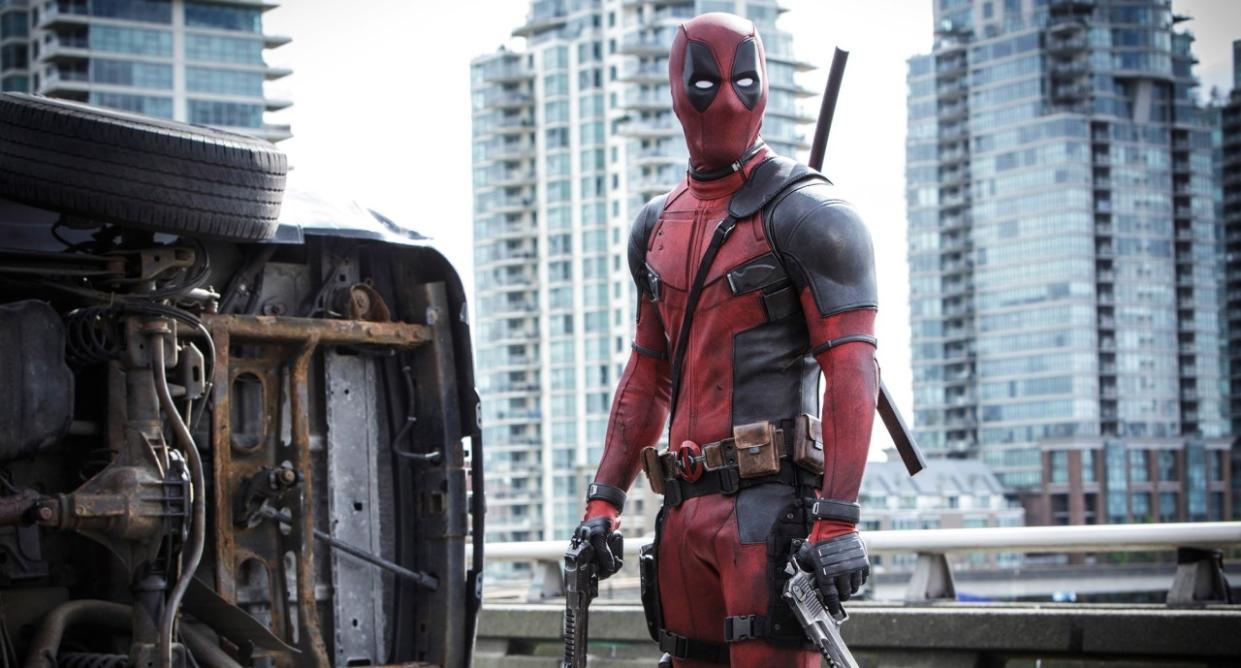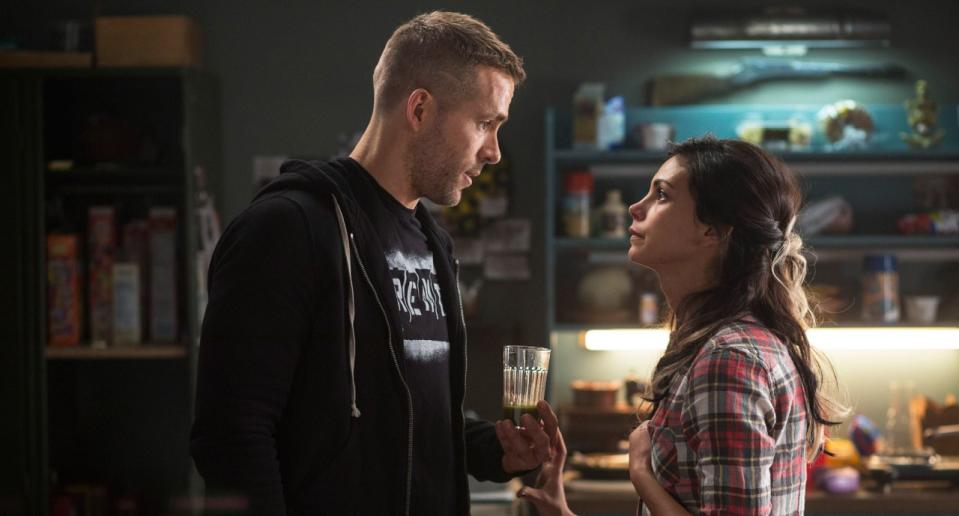'Deadpool' Screenwriters Go Deep: X-Men Choices, De-powering Copycat, and All Those Sex Jokes

Ryan Reynolds as Deadpool (Fox)
Even within the tortured realm of Hollywood movie development, the path from page to screen for this weekend’s R-rated superhero joint Deadpool was an unusual — and often painful — one.
“We wrote it six and a half years ago and have written a draft of the script in every calendar year since,” Paul Wernick, who penned the Ryan Reynolds-starring film with his Zombieland collaborator Rhett Reese, told Yahoo Movies. “It’s been a crazy, crazy journey. We tried to roll the ball up the hill time after time, only to see it roll back down and crush us over and over again. And understandably so, because it’s an outlier. Hollywood is so driven by fear, it’s taken a lot of courage to get here, for 20th Century Fox to make a movie where the love story ends with our heroine saying, ‘It’s a face I’d be happy to sit on’.”
The movie looked all but dead a few years ago, until somebody leaked test footage of a big fight scene that they had shot as proof of concept. Fans loved it, and all of a sudden, the foul-mouthed mutant mercenary, who popped up in 2009’s flop X-Men Origins: Wolverine, had his own movie officially green-lit (or so the neat narrative goes). And after all the re-writes, the film retains about 70 percent of the original script that Wernick and Reese wrote all those years ago.
Deadpool, directed by visual effects ace Tim Miller (Scott Pilgrim vs. The World) is an unconventional superhero movie in several ways: It’s an origin story, charting Deadpool’s course from mouthy mercenary to scarred mutant; but it also presents a second timeline set in the modern day, when our hero must rescue his girlfriend Vanessa (Morena Baccarin) and get revenge on the man who disfigured him (Ed Skrein). It’s also filled to the brim with filthy wisecracks and not-so-subtle euphemisms, making it the first big R-rated superhero flick — a status it very much earns. Wernick and Reese spoke with Yahoo Movies about writing the film, its unusual structure, dealing with the X-Men universe, and more.
This an origin story, but with a different structure: It’s twisted, starting in the present and then going back and forth between the past and continuing the story. What was the thinking behind that?
Reese: When we first pitched the story to Ryan, we pitched a non-origin story, and he didn’t want to do it. And it ultimately took some time to get him to let us sit him in the room with him again. He thought the origin story was really important. And we were spitballing and said, "What if we combined an origin story with a more modern story that had two timelines that converged at some point?” And we originally thought maybe we’d do some traditional flashbacks. But as we sat in a room and looked at the corkboard and the scenes, we thought you could actually start in the present and work your way back. And then have the fourth wall breaking and the narration weave you back and forth, kind of helter-skelter, in between the two time frames.
I think what it ended up doing was it allowed us to balance the two tones. The past scenes are a little darker. There’s cancer, there’s torture, there’s loss. The present scenes are more silly and Deadpool is in his suit for most of them and they’re wacky and a little cartoony sometimes, with a lot of pop culture references.
Another reason we did it was budget. It allowed us to take one action scene, the scene out on the freeway, and extend it to later in the movie. The present-day story really only takes place over the course of about 24 hours. The past story takes years, and so you’re trying to have the two mesh. And I think where it unlocks for us was parsing out that first hour out on the bridge for over half the movie. And then having the two timeframes collide about two-thirds through the movie and become one. Deadpool can literally use a fast-forward button, because we didn’t have to adhere to any normal rules.
Related: ‘Deadpool’ Review: Dirty, Irreverent Fun
Why did you decide to go with Colossus and Negasonic Teenage Warhead as the two X-Men we see in the film?
Reese: You do have a very serious legal issue in that there are certain characters you can use and certain characters you can’t. Deadpool falls under X-Universe, so he’s owned by Fox. They have a long master list of characters they have the rights to. And it was really important to us to have one of the strong traditional X-Men. And a lot of those characters have been really well explored in the X-Men movies, and Colossus less so, given his impact in the comic. So we thought he was an underused opportunity, and also he’s a great foil to Deadpool because he’s very self-serious and goody- two-shoes and Deadpool’s clearly the exact opposite.
And Negasonic Teenage Warhead, her name really jumped out at us. She was a very minor character by contrast. She only appeared in one issue of one comic. But the name was so delightful that we were like, “We’ve got to build a character just around that name.” So we ended up throwing out her character in the comics and giving her a new power: The ability to turn herself into a warhead, which we thought made much more sense than her actual power, which was like psychic abilities. So once we gave her that, we thought, let’s just play to teenaged. What would a teenage girl be like? And so often we’ve been around teenaged girls who are silent all the time and just have their heads buried in their phone.
Watch the NSFW red-band trailer:
Hugh Jackman and Wolverine also act as a good foil for Deadpool, even though he’s not in the movie. You reference him and make fun of him a whole lot. Who had to approve that?
Reese: The great thing about it is that Hugh was a little bit like a guardian angel for us. He was very supportive of the movie, he was very supportive of us poking fun at Wolverine. He’s a buddy of Ryan’s, so every request we made of him — like, can we use your People’s Sexiest Man Alive cover? — those were Hugh questions, they weren’t studio questions. And Hugh, every single time, was like, “Do it. I think that’s hilarious.”
And Wolverine, because he was the first really edgy, fun X-Men character, cast a pretty long shadow over our movie — in a good way. It feels like his spirit is mixed in. And I know in the comics it’s Wolverine’s healing factor that they inject into Deadpool. We didn’t explore that so much because we thought it would be confusing for the audience. But his DNA is in Deadpool, in that he’s a rebel and his temper gets the best of him. So Hugh was kind of inspirational and if he hadn’t been so willing to let us do those things, I don’t think the movie would be quite what it is.
Vanessa is a mutant in the comic book — as Copycat — but not in the movie. So why did you decide to take those powers from her?
Wernick: Well, the movie is called Deadpool, and because we were re-creating this character, we wanted to focus entirely on Deadpool, on Wade Wilson becoming Deadpool. There may be a moment in time, if we’re so lucky to make more of these movies, that Vanessa becomes Copycat and we see her evolve and her powers come to life.
Reese: And we have to make it make sense. I think comic logic and movie logic aren’t the same. There was a certain coincidental nature to this idea that she’s also a mutant after he was getting powers. So we thought we could find ways to add a logic to that down the road that we just didn’t feel like we could reasonably do easily and efficiently in this movie.

Ryan Reynolds and Morena Baccarin in ‘Deadpool’ (Fox)
Have they given you a sense of where this fits in, down the road, with future X-Men movies? Or what you’d have to do next?
Wernick: Simon Kinberg is the keeper of the X-Universe, and in that brilliant mind of his, he has it all patterned out, how it all shakes out over the course of the next bunch of movies. You’ve got timelines that you’ve got to worry about, obviously, from the X-Men movies.
Reese: We haven’t seen X-Men: Apocalypse. We don’t know what’s coming. He knows what’s coming, and he also knows what’s the plan after Apocalypse. It’s much easier for us to figure out how to plug X-Men into Deadpool’s universe than to figure out how to plug Deadpool into other universes. And that will be something that probably collectively, if we succeed, we’ll all come together on. Ryan did pay us the ultimate compliment the other day when he said, “I don’t want anyone putting words in Deadpool’s mouth other than these guys.”
So, just how many d–k jokes did you write for this movie?
Reese: Oh god, a fair amount. And this is throwing credit Ryan’s way, not blame, but he does improvise a lot too. Some of the funniest things in the movie was just stuff he just blurted out on the day, or thought of the night before and just threw it in there. He has a very fertile comic mind. So we wrote a lot of d–k jokes, and he threw a few more extra in there. We had a fair amount, but if you put us up against the Apatow and Seth Rogen movies, we actually have fairly fewer.
Were there any stand-out lines he improvised?
Reese: Here’s a great example. Paul took a pass at a scene where Deadpool goes to the door to convince Negasonic Teenage Warhead and Colossus to come to help him at the end of the movie. We all end up contributing jokes here and there. But Ryan, on the day, as he was walking away from the door, just said out of the blue, “You know it’s funny how I only see the two of you here. It’s like the studio couldn’t afford any more X-Men.” And the whole crew just burst into an explosion of laughter. And he just kind of thought of it. It’s the head of the studio, Jim Gianopulos’ favorite line. It comes from a place of truth: We couldn’t afford any more X-Men. That moment in particular better than any other illustrates why writing for Ryan Reynolds is a joy. He makes you look better.
Rather than kick off with the traditional list of names of its principals, Deadpool has some fun at its own team’s expense. The opening credit sequence is a gutsy tone-setter, especially calling yourselves geniuses.
Reese: We were really going to strike a blow for writers in that moment, but because you know writers wrote it, it’s a wink, an ironic and self-aggrandizing line. And in that case, we wrote our credit, Tim wrote his credit, and Ryan wrote his credit, because we thought we should each come up with our own credit. It was very tongue in cheek from the beginning. Someone had the idea to do faux-credits, and to have, where you’d usually see “A Steven Spielberg Film,” it says, “A Some D—–bag Film,” it sets the tone for what’s coming.
Wernick: But let’s make it clear: We are not calling Steven Spielberg a d—–bag.
Watch our interview with ‘Deadpool’ star Ryan Reynolds:
